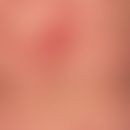HistoryThis section has been translated automatically.
The Drosophila "patched" gene (PTC) encodes a transmembrane protein that represses transcription of genes encoding members of the TGF-beta and Wnt (164820) signaling protein families in certain cells.
Homologs of PTC have been identified in mice, chickens, and zebrafish.
Johnson et al. (1996) reported the isolation and mapping of the human homolog of the PTCc gene from Drosophila. They cloned the human PTC gene. The predicted amino acid sequence of the encoded protein is 96% identical to that of mice and 40% identical to that of Drosophila PTC proteins. The human PTC protein contains 12 hydrophobic membrane-spanning domains and 2 large hydrophilic extracellular loops.
Hahn et al (1996) also isolated a human sequence with strong homology to the Drosophila segment polarity gene "Patched" from naevoid basal cell carcinoma (NBCCS) gene material on chromosome 9q22.3.
DefinitionThis section has been translated automatically.
The PTCH1 gene ( PTCH1 is the acronym for Patched 1) is a protein-coding gene located on chromosome 9q22.32. Diseases associated with PTCH1 include basal cell nevus syndrome and holoprosencephaly 7.
Associated signaling pathways include the Hedgehog Signaling Pathway and "Signaling events mediated by the Hedgehog family".
An important paralog of this gene is PTCH2.
You might also be interested in
General informationThis section has been translated automatically.
The PTCH1 protein acts as a receptor for:
- Sonic Hedgehog (SHH)
- Indian Hedgehog (IHH) and
- Desert Hedgehog (DHH).
PTCH1 protein associates with Smoothened protein (SMO) to relay the signal of Hedgehog proteins. It appears to have a tumor suppressor function, as inactivation of PTCH1 protein is likely a necessary, although an insufficient step on its own, for tumorigenesis.
Mutations in the PTCH1 gene are associated with nevoid basal cell carcinoma syndrome, keratocystic odontogenic tumor (KCOT), a locally aggressive growing cystic lesion of the jaw that occurs sporadically or in association with nevoid basal cell carcinoma syndrome (NBCCS) (Guo YYet al. 2013). In breast carcinoma, mutations in the PTCH1 gene are associated with poor prognosis (Wang CY et al. 2019).
Note(s)This section has been translated automatically.
The Drosophila "patched" gene (PTC) encodes a transmembrane protein that represses transcription of genes encoding members of the TGF-beta and Wnt (164820) signaling protein families in certain cells.
Homologs of PTC have been identified in mice, chickens, and zebrafish.
Johnson et al. (1996) reported the isolation and mapping of the human homolog of the ptc gene from Drosophila. They cloned the human ptc gene. The predicted amino acid sequence of the encoded protein is 96% identical to that of mice and 40% identical to that of Drosophila PTC proteins. The human PTC protein contains 12 hydrophobic membrane-spanning domains and 2 large hydrophilic extracellular loops.
Hahn et al (1996) also isolated a human sequence with strong homology to the Drosophila segment polarity gene "Patched" from nevoid basal cell carcinoma syndrome (NBCCS) genetic material on chromosome 9q22.3.
LiteratureThis section has been translated automatically.
- Guo YYet al. (2013) PTCH1 gene mutations in keratocystic odontogenic tumors: a study of 43 Chinese patients and a systematic review. PLoS One 8: e77305.
- Skoda AM et al (2018) The role of the Hedgehog signaling pathway in cancer: A comprehensive review. Bosn J Basic Med Sci 18: 8-20.
- Wang CY et al (2019) Mutation of the PTCH1 gene predicts recurrence of breast cancer. Sci Rep 9:16359.






